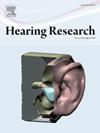Evaluating the role of age on speech-in-noise perception based primarily on temporal envelope information
IF 2.5
2区 医学
Q1 AUDIOLOGY & SPEECH-LANGUAGE PATHOLOGY
引用次数: 0
Abstract
Acoustic amplitude modulation (AM) patterns carry important information, particularly in speech. AM masking, influenced by frequency selectivity in the modulation domain, is considered a crucial factor for speech intelligibility in noisy environments. Based on recent evidence suggesting an age-related decline in AM frequency selectivity, this study investigated whether increased AM masking in older listeners is associated with reduced speech intelligibility. Speech reception thresholds (SRTs) were measured using tone-vocoded speech and maskers with no modulation, broadband AM, or narrowband AM at varying modulation frequencies. AM masked thresholds were assessed for a 4-Hz target modulation frequency. The study included young (N = 14, 19–25 years) and older (N = 14, 57–79 years) listeners with normal hearing. It was hypothesized that SRTs would be higher for the older group with modulated maskers and that the age-related increase in SRT would depend on the masker's modulation frequency content. The speech intelligibility results showed that maskers with broadband AM produced higher SRTs than unmodulated maskers. However, SRTs varied little with masker-modulation center frequency across the range tested (2–32 Hz). While older listeners exhibited lower AM frequency selectivity than young listeners, they did not consistently exhibit higher SRTs than their young counterparts across maskers. However, there was a trend for the effect of age to be greater for maskers with broadband AM than for unmodulated maskers. Overall, despite supportive trends, the results do not conclusively demonstrate that older listeners are more susceptible than young listeners to AM masking of speech.
基于时间包络信息评价年龄对噪声中语音感知的影响
声学调幅(AM)模式携带重要的信息,特别是在语音中。调幅掩蔽受调制域频率选择性的影响,被认为是影响噪声环境下语音清晰度的关键因素。基于最近的证据表明,调幅频率选择性与年龄相关的下降,本研究调查了老年听众增加的调幅掩蔽是否与语音清晰度降低有关。语音接收阈值(srt)使用音调编码语音和无调制掩模、宽带调幅和窄带调幅在不同调制频率下测量。对4 hz目标调制频率进行调幅屏蔽阈值评估。该研究包括听力正常的年轻听众(N = 14, 19-25岁)和老年听众(N = 14, 57-79岁)。假设使用调制掩蔽物的老年人的SRT会更高,并且与年龄相关的SRT增加取决于掩蔽物的调制频率含量。语音清晰度结果表明,宽带调幅掩模比无调制掩模产生更高的srt。然而,在测试范围内(2-32 Hz), srt随掩蔽调制中心频率变化不大。虽然老年听众比年轻听众表现出更低的调幅频率选择性,但他们并不总是表现出比年轻听众更高的srt。然而,年龄对宽带调幅掩蔽器的影响大于对未调制掩蔽器的影响。总的来说,尽管有支持的趋势,但结果并不能最终证明老年听众比年轻听众更容易受到语音调幅掩蔽的影响。
本文章由计算机程序翻译,如有差异,请以英文原文为准。
求助全文
约1分钟内获得全文
求助全文
来源期刊

Hearing Research
医学-耳鼻喉科学
CiteScore
5.30
自引率
14.30%
发文量
163
审稿时长
75 days
期刊介绍:
The aim of the journal is to provide a forum for papers concerned with basic peripheral and central auditory mechanisms. Emphasis is on experimental and clinical studies, but theoretical and methodological papers will also be considered. The journal publishes original research papers, review and mini- review articles, rapid communications, method/protocol and perspective articles.
Papers submitted should deal with auditory anatomy, physiology, psychophysics, imaging, modeling and behavioural studies in animals and humans, as well as hearing aids and cochlear implants. Papers dealing with the vestibular system are also considered for publication. Papers on comparative aspects of hearing and on effects of drugs and environmental contaminants on hearing function will also be considered. Clinical papers will be accepted when they contribute to the understanding of normal and pathological hearing functions.
 求助内容:
求助内容: 应助结果提醒方式:
应助结果提醒方式:


